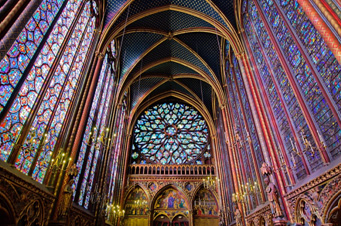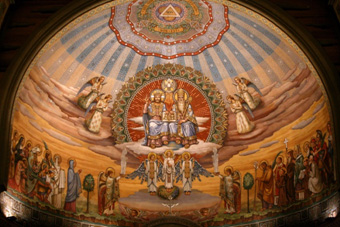Mass of the Solemnity of the Most Holy Trinity

Introduction for the Mass of the Solemnity of the Most Holy Trinity
St Mary’s Cathedral, Sydney, 31 May 2015
Welcome to St Mary’s Cathedral for the Solemnity of the Most Holy Trinity. Today we recall the mind-blowing reality that God is one and God is three, and that the love of those three persons for each other overflows into the creation, redemption and ultimate glorification of our universe and each one of us.
After Mass we will bless the new statues in the reredos of the Lady Chapel. I welcome the Friends of St Mary’s Cathedral and the representatives of the benefactor communities and families who are attending this Mass and blessing.
I am also pleased to welcome Joshua Ryan, with his mother and grandmother. Joshua was formerly an organ scholar here at the Cathedral and today is being received into full communion with the Church. On behalf of the Cathedral community I say: welcome to the Church Josh. May the Father who sustains the universe, the Son who redeems it and the Spirit who inspires it, dwell always in your heart.
Homily for the Mass of the Solemnity of the Most Holy Trinity
St Mary’s Cathedral, Sydney, 31 May 2015

https://lifeaperture.files.wordpress.com/2012/01/dsc0051.jpg
A few days ago the stained glass windows of Sainte-Chapelle were revealed in all their glory. The former royal chapel sits in the heart of Paris on the Île de la Cité near Notre Dame. For seven years it has been closed or obscured by scaffolding while centuries of grime were removed, stone and paint renovated, and the lead joinery replaced with clear glue. This thirteenth century jewel-box of a church houses the relic collection of St Louis IX, including the putative Crown of Thorns, and its walls and spires are made of stained glass depicting the history of salvation from Eden to Calvary. But what visual imagination finds much harder to grasp and stained glass much harder to depict is the prequel to that story, the ‘story’ of God, Three divine persons in One divine substance from all eternity.
In our first reading today Moses, the mediator of so much of the Jewish religion, puzzled over the nature of God. Convinced that God is pure spirit, he insisted that no statue or glass could portray Him. Fires and wind, signs and wonders might hint of God’s presence. But to think of God, Moses says today, we should think not image but Word, a word beyond compare, a Voice speaking from beyond heaven and earth, a Law or Plan for human beings that will make them “prosper and live long in the land” (Dt 4:32-40).
Moses knew human beings could sometimes speak for God: his was an awesome responsibility that the prophets following after him would share. The Eternal Word would in a sense ‘take flesh’, in or through the voice-boxes of mere mortals. But he never guessed that in the fullness of time that Word would literally take flesh in Jesus Christ and reveal to us that the One true God is Father, Son and Holy Spirit.
Though Moses was no friend of idols and gods that looked like calves or men, he also knew that human beings are “made in God’s image”, with the divine attributes of thinking, loving and choosing; in human beings we glimpse these three dimensions of God. As the early Church Father, St Irenæus, famously said: “The glory of God is man fully alive, and the life of man is the vision of God.” (Adversus Haereses IV, 20, 7). So when Moses talks today about God’s commandments he is not referring to an arbitrary rule-book that makes Jews different: he is pointing to a divine plan that human beings would couple and form families, tribes and nations, love God above all, and live and work in justice and peace. So, too, when Jesus commissioned His disciples to make disciples of all nations, baptizing them in the name of the Father and of the Son and of the Holy Spirit, He added that they must teach them to obey my commandments (Mt 28:16-20). Even if His law is spirit and truth, freedom and life, it makes its demands and when lived fully makes manifest God’s glory.

http://blog.cleveland.com/metro/2009/09/holy-trinity-church-fresco.jpg
Which brings me to hot topic of the moment: same-sex ‘marriage’. We all know and love someone with same-sex attraction. We want them to be happy. So we all feel the tug of the view that everything that makes heterosexuals happy should be open to same-sex attracted people – including marriage. But Moses thought, Jesus thought, that marriage is essentially heterosexual: it is about a man leaving his mother and father and cleaving to his wife, so the two became one flesh (Gen 2:24; Mt 19:5; Mk 10:7; Eph 5:31); on that would be based the family, the nation, the Church.
Some would now redefine marriage as a public commitment between any two people who love each other. They say they want ‘marriage equality’. Well so do I: I think all marriages should be treated equally and all married people treated with the respect and given the support marriages deserve. But before we can treat all marriages equally, we have to know what a marriage is. Before we morph marriage into something else, we should know why Jesus and all generations before our own thought it’s about a man and woman.

For starters, marriage doesn’t just harmonise two people’s emotional lives. Marriage has always been valued for holding together things which otherwise tend to pull apart: sex and love, love and babies, men and women, babies and parents. Not every marriage successfully unites all these things, but only the union of a man and woman can possibly do so. Nor does every marriage end up with kids, but every kid has a mum and dad. Marriage exists to bring a man and woman together so that, in the normal course of things, they become father and mother to any kids their love procreates, and then to hold them together so those kids have both mum and dad for the long haul.
Reducing marriage to whatever gives adults emotional satisfaction leaves us with no real reason why such a union should be “for life” (as feelings aren’t), no real reason why it should be between only two people (three or more might love each other too), and no real reason why government should regulate it at all (we don’t need a registrar to tell us who to love or for how long).
Some would dismiss my contribution to this debate as faith-fuelled bigotry. So let me be absolutely clear today: to the extent that churchmen or other Christians have been guilty of prejudice I am ashamed and sorry. Often in history and sometimes still today, people with same-sex attraction have suffered injustice or unlove from some believers. That is to be deplored.
But the idea that marriage is between man and woman is no monopoly of Jews and Christians: every major world religion has thought so. Nor is the idea peculiarly religious: every major civilisation till now has thought so. Even in highly diverse and sexually opportune cultures like ancient Greece marriage was reserved to a man and a woman.
No one thinks it’s wrong to restrict primary schools to children, women’s hospitals to women, Aboriginal land rights to indigenous Australians… some things are precisely for them and exist because of them. So, too, to claim that there are differences between men and women, mothers and fathers, parents and children, and to support an institution built around those distinctions, need not be discriminatory. What is unjust is to pretend these differences are irrelevant to the lives of all those already married, those who might in future want real marriage, or those whose families are founded on this relationship.
Many people today find it hard to commit to marriage and stay married. There are lots of reasons for that. But further deconstructing marriage will only add to confusion about what this institution is and is for, and weaken it more. We can and should do more to ensure same-sex attracted people are treated with respect and love. But to do so we don’t have to mess with marriage and undermine it further. The Australian bishops have published a pastoral letter on the topic which is available now on-line and will be available in print this week.
The God revealed to Moses and the Jews, the God revealed in Jesus to Christians, is a God with a plan for humanity to make us happy. He is very different to the false gods of sex disconnected from marital love and procreation, of power unmoored to service, and honour separated from merit. This three-personal God gives us intellect, feelings and freedom so each of us can image His three persons in one. But through marriage He enables us to do this even more fully as 1+1 makes 2, then 1 as the man ‘cleaves’ to his wife, and then 3 as their children follow. This is how marriage can be a sacrament of Christ’s relationship to His Church. And this is how marriage can be an icon of that Holy Trinity in which one person begets another and from the two proceeds a third. Marriage can be that stained glass through which the world might glimpse the story of God.
Words after Communion for the Mass of the Solemnity of the Most Holy Trinity
St Mary’s Cathedral, Sydney, 31 May 2015
Above the High Altar you will see several make saints, mostly apostles, with Christ. Above our Lady Altar we now have beautiful new statues of prominent female saints which we will bless immediately after Mass. These include:
• St Hildegard of Bingin, who was twelfth century Benedictine mystic and doctor of the Church – and we have the Benedictine Sisters of Jamberoo Abbey to thank for her statue;
• St Catherine of Siena, a fourteenth century mystic and lay tertiary of my own Dominican order, the only doctor of the Church who is neither cleric nor religious – the Dominican Sisters of Eastern Australia and the Solomon Islands contributed her image and I welcome their Congregational Prioress Sr Judith Lawson OP and her Sisters;
• St Teresa of Avila, another mystic doctor of the Church and famous sixteenth century theologian of the contemplative life – with thanks to Mr Richard Stevens;
• another brilliant Carmelite, the twentieth century Teresa Benedicta of the Cross, St Edith Stein, Jewish convert, philosopher and martyr of Auschwitz – my gratitude the German speaking Catholic communities of St Christophorous and St Raphael, represented today by Fr Roland Maurer, German chaplaincy parishioners and visitors from St Hedwig’s Retirement Village;
• Australia’s own Mary MacKillop, St Mary of the Cross, founder of the Sisters of St Joseph – whose statue was funded by Ms Jacqueline Roche;
• Blessed Teresa of Calcutta, the great friend of the poor and the dying – I thank Anthony Lahood, the Lahood family and Mary Benbow for their devotion to her;
• St Maria Goretti, virgin and martyr who is a patron both of Catholic sexual teaching and of forgiveness – for this statue we thank the Passionist Community and St Brigid’s Parish, represented by Fr John Pearce Parish Priest and parishioners of Marrickville;
• St Monica, mother of St Augustine of Hippo, whose constant prayers helped convert her son and might be regarded as a special patron of all those parents and grandparents today who worry about whether their children and grandchildren will have and practice and live the faith – my appreciation to Ms Annette Marskell OAM for Sr Monica Newman RSM.
God bless you for your contributions. All Holy Women of God, pray for us!

